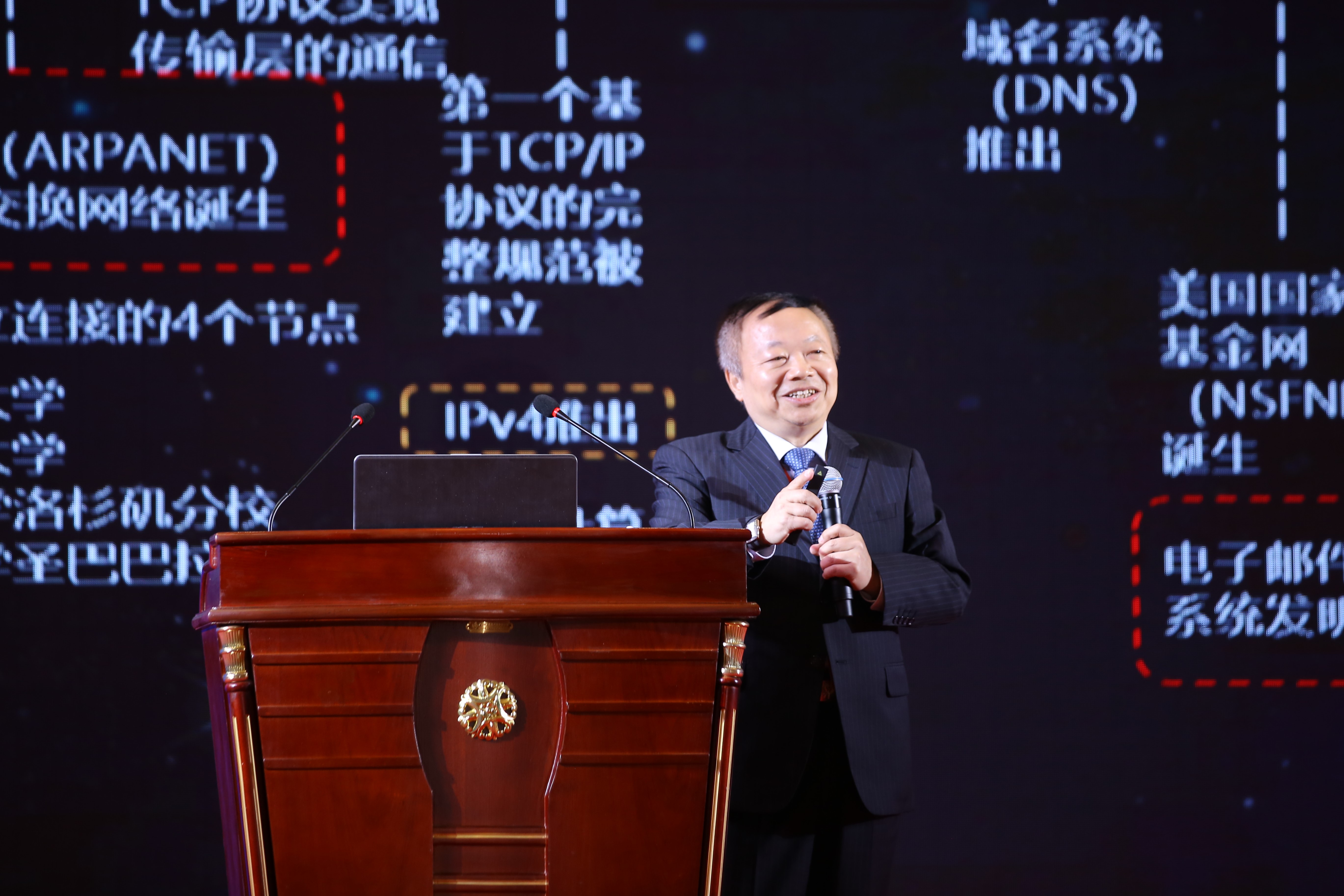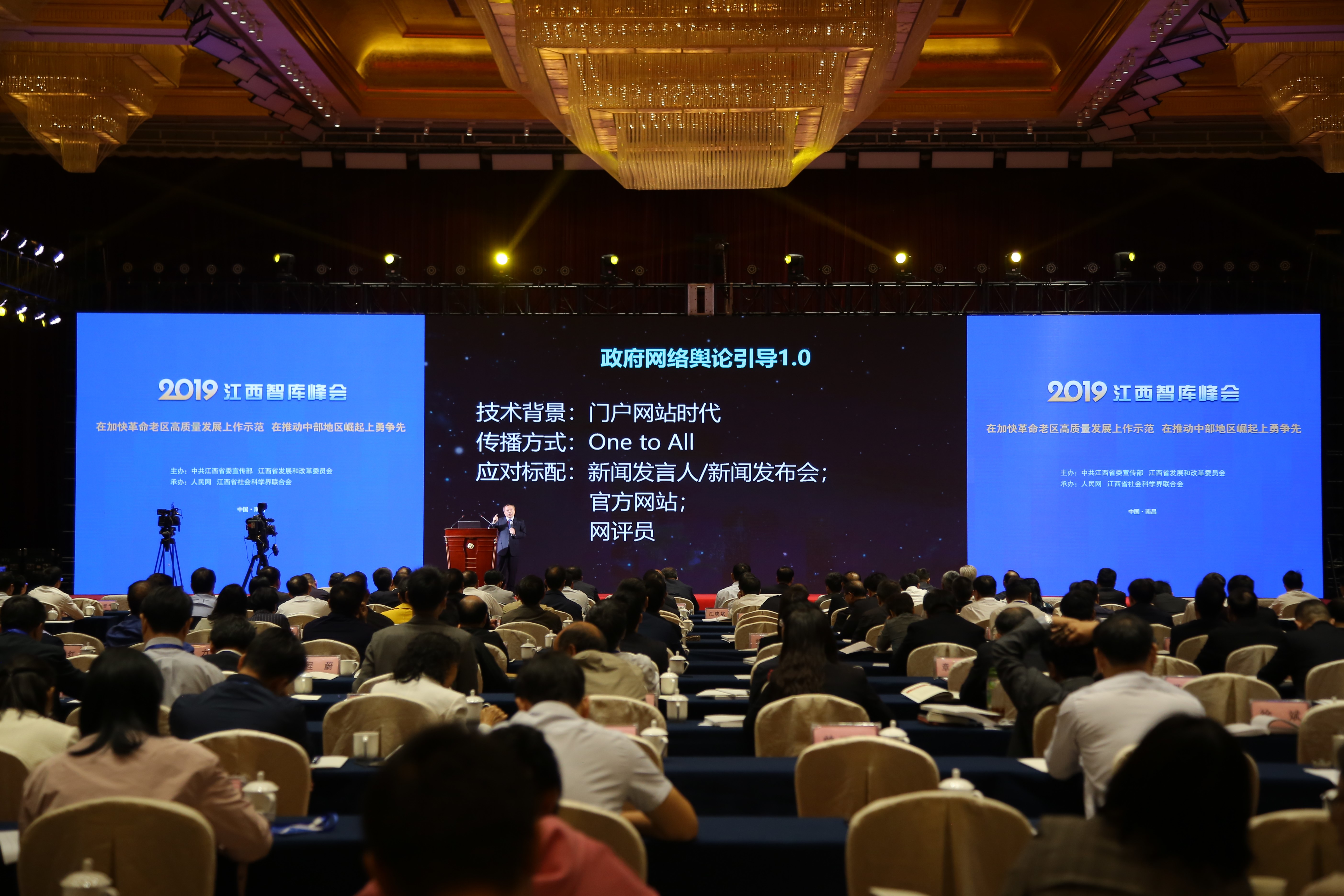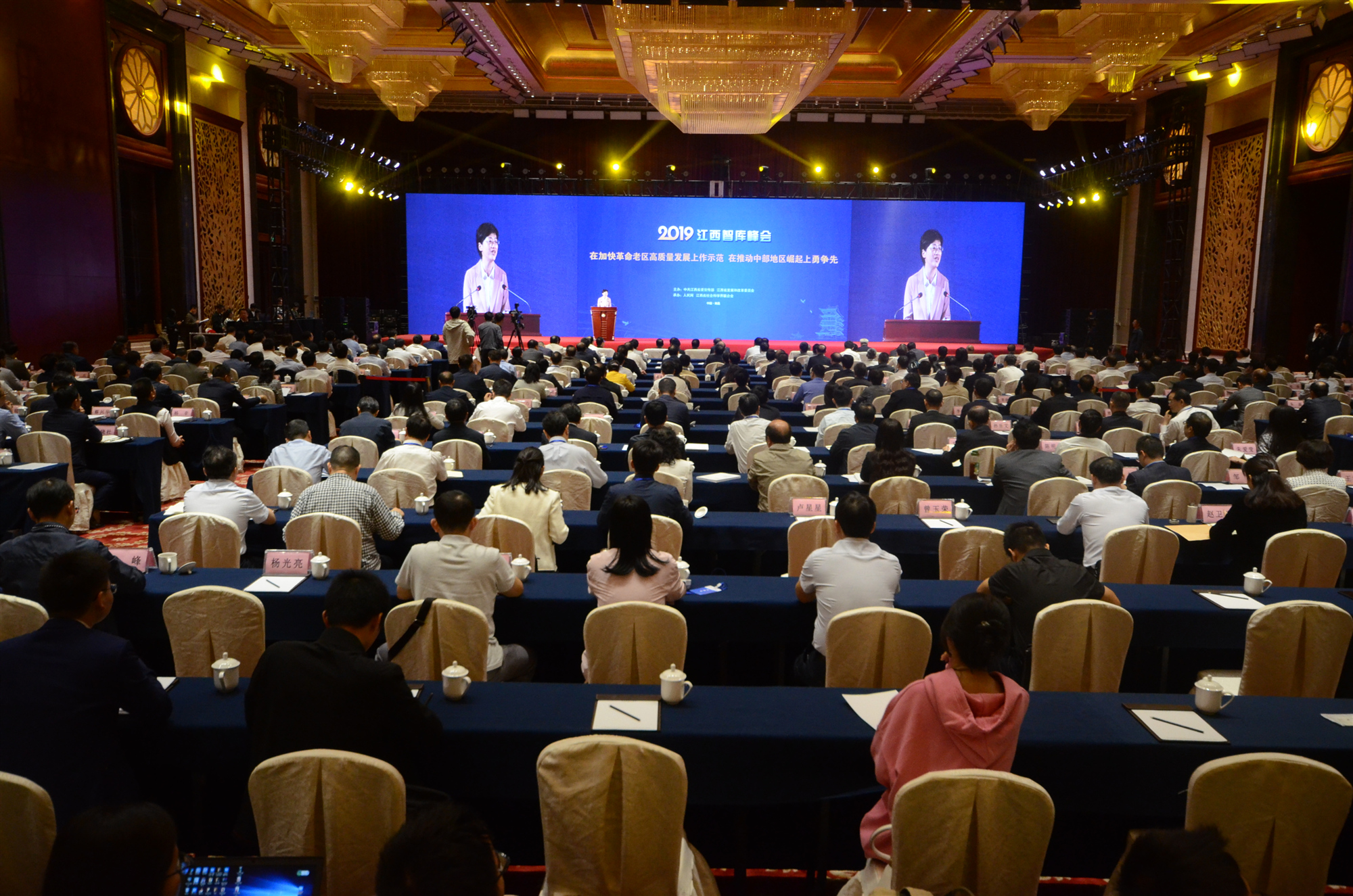Introduction: Mr. Peng Bo, Senior Researcher of Taihe Institute, Vice Director of Cyberspace Administration of China (CAC) (2012-2015), delivered a keynote speech titled "Government Network Public Opinion Guidance and Social Governance Have Entered the 3.0 Era" at 2019 Jiangxi Think Tank Summit.
The Internet is the greatest basic scientific and technological invention of the human society in the 20th century, and is the symbol product of the information society, which is equivalent to the steam engine and electric power in the industrial society. The popularization and development of the Internet will certainly trigger the unprecedented scientific and technological revolution and industrial revolution, and will further trigger profound social changes as well. Similarly, the development of the Internet also brings severe challenges to the governing ability and status of the Communist Party of China (CPC or Party) and the Chinese government. But over the years, we have seen the reality that the CPC and the government have "built, utilized, and managed" the Internet well and turned this "biggest variable" into the "biggest increment" of business development.
I. The First Two Stages of Internet Public Opinion Guidance
How to hear the voice of the Party and the government in the noise of the crowd? How to understand the voice of the Party and government in the midst of all the hubbub? This is the main purpose of public opinion guidance by the government. After so many years of exploration, we have gradually mastered the key to guiding network public opinion. Internet public opinion field is based on the Internet, the Internet is based on technology, and the technology of the Internet is constantly developing, which will have an impact on the principles of the formation and evolution of public opinion and will influence the public opinion field as well. Therefore, when it comes to public opinion guidance, an important trick is to keep pace with the times and keep pace with the technology.
Let's review the first two stages of public opinion guidance. The first stage was government-centered. The technical background of this stage was the era of Internet portal websites. In that era, the communication mode of the whole Internet was identical to traditional media and still followed the pattern of "One to All" and "I speak, you listen". Based on this, our means of responding mainly lay in letting the people hear the voices of the CPC. Hence, the standard pattern of response was press spokesman, press release and official websites. At this time, the focus of our work was "speaking". We should speak boldly, in a timely manner, and not speak recklessly.
The second stage was to focus on the public. What does it mean to be public-centric? Major changes have taken place in the way that social networks spread, not "One to All", but "All to All", all of whom are producers, publishers, and consumers of information. At this time, the government’s standard configurations are the government microblog, WeChat, Toutiao and Tik Tok accounts, etc. In this "All to All" era, the government must speak to the audience on the same platform. After the emergence of major public opinion, the government should come forward and speak louder at a higher decibel level than others. At the same time, we need to speak together, because a single voice will not be heard. All media, including all new government affairs media should speak together, so that the public can hear these voices.
II. Challenges in the Digital Technology Era
The digital era has brought new challenges. "A" represents Artificial Intelligence, "B" represents blockchain, "C" represents cloud computing, and "D" represents big data. Together with the emergence of 5G mobile communication technology, this means a new era has dawned, which is the beginning of the second half of the Internet era. The first half is the information technology era (IT), while the second half is the digital technology era (DT). With today's technological breakthroughs and the explosive growth in information, human society is now rapidly moving forward from the information technology era into the digital technology era. New trends represented by big data, cloud computing, blockchain, artificial intelligence and other digital technologies is developing rapidly, and will further release their power in the era of 5G. The improvement of information capacity and the reform of communication modes will not only lead to a new round of economic and industrial upgrading, but also reshape social networks and promote the transformation of the social governance model. In the move from IT to DT, how will the public opinion field be changed? What new challenges will be faced by the government? I believe these changes will be manifested in the following six main respects.
1. As far as the time dimension is concerned, the information transmission will further break the time limit, and the transmission speed will be faster, and the time left for the government to respond will be shorter. The government must respond immediately in order to coordinate with the development of public opinion.
2. As far as the spatial dimension is concerned, 5G media system will further break through the spatial distance and regional restrictions. At the same time, in the age of 5G Internet, the spatial capacity of information itself will be greatly enhanced. More importantly, in the field of global public opinion, based on 5G, the flow and flow rate of information globalization will increase, which will have a bigger impact on the domestic public opinion field.
3. As far as the form dimension is concerned, the real-time live broadcast will become the mainstream media form thanks to the breakthrough in time and space, which is called "no network without video". Video will act as a basic information carrier and grow geometrically, making the public opinion field even more uncertain.
4. In terms of the supply scale, the amount of information in the public opinion field will expand unprecedentedly in the digital technology era. From portal websites to weibo, weixin, and the Internet of Things, every iteration of the new media will lead to a 100-fold increase in the size of the public opinion field, and it is difficult for the government to follow up on the resources and skills.
5. In terms of the information supplied, there is a huge demand for high-quality contents. There are two major concerns. On the one hand, the supply side is insufficient. Can the government provide sufficient information? On the other hand, the demand side faces the problem of information overload. How can the government provide accurate services? Both of them pose challenges for us.
6. In terms of the means of expression, to ensure that ordinary people understand, we need to say what they are willing to listen to, and should publish information in a way that the ordinary people enjoy hearing and watching.
In short, the government’s network public opinion guidance needs to keep pace with the times, and should be upgraded to a higher level, which means the entering of the 3.0 era of network public opinion guidance.
III. Government Network Public Opinion Guidance in the 3.0 Era
The continual development of new technologies and applications on the Internet has increasingly strengthened the capacity of Internet social mobilization, brought new opportunities and means for the government to guide network public opinion, and at the same time, exposed the government to many new challenges and problems.
What is at the core of the government's network public opinion guidance in the 3.0 era? It is based on big data, driven by algorithm, with every citizen as the center, and provides the best information service for every citizen. This is the most important part of the future information service model. The evolution of information distribution has gone through three stages. The first was "One to All", then "All to All", and the future will be "All to one". In the era of Big Data, the government actually controls 80% of the information. It can be said that the government is the host of the era of Big Data. Why can we say that the government is able to provide services for everyone? Because it masters big data and the most advanced algorithms. Here I propose 10 suggestions for government to guide network public opinion effectively in the 3.0 era.
1. Use big data to grasp the full picture of the most complete social public opinion. Mobile terminal users are both data users and contributors, which results in vast and varied personalized data resources. The personalization of mobile terminals enables media content consumption to be personalized, and the richness of big data resources is the prerequisite for the satisfaction of personalized information demands.
2. Effectively manage changes in Internet public opinion by using Artificial Intelligence. It is necessary to find a more essential and accurate model of social relationships, establish a mathematical model based on this, and subsequently form algorithmic systems, after which use relevant big data resources as computing materials to create intelligent solutions.
3. Process large-scale information with cloud computing. All types of Information and Communication Technology (ICT) should be uniformly organized and flexibly utilized through the network to build a shared resource pool, and information processing methods of large-scale computing should be realized and provide services to users in a dynamically demand-based and measurable manner.
4. A new mechanism of trust should be established with Blockchain. Trust is the foundation of economic activity, so trust mechanisms need to adapt to different economic forms, and a new trust mechanism in the digital economy era should be built.
5. Government websites should be optimized with digital technology. We need to build an interlinked, highly effective online government that benefits people by arranging the central government network as the leader and placing local government networks in support.
6. Accurately disseminate government information using the algorithms of new media platforms. Platforms like WeChat, Weibo, Toutiao provide channels that directly reach every ordinary Chinese citizen. These platforms understand each user better than the users themselves do. Therefore, such platform can accurately recommend information. Why not use these commercial platforms to provide the government information that users need?
7. Using the Internet of Things to Prepare for a New Entry. The new IoT portal war has begun, and we should embrace IoT (Internet of Things) and move towards IoE (Internet of Everything).
8. Videos should be used to take the lead role in "everything is on screen". In the government's next step, videos should be prioritized as the principal means of guiding public opinion. Namely, "no video, no guidance".
9. Benefit the public with personalized, proactively recommendatory intelligent services.
10. Cover the largest number of people with the new media matrix. We need to build a "regular army division" in the field of Chinese Internet public opinion.
IV. Government's social governance in 3.0 era
"With the development of the Internet, especially the mobile Internet, the social governance model is shifting from one-way management to two-way interaction, from solely offline to the integration of online and offline, and from simple government supervision to a more collaborative form of social governance" said by the Chinese President Xi Jinping recently. He particularly stressed that "we need to have a deep understanding of the role of the Internet in national management and social governance". In particular, the issue of "precision of social governance" was emphasized.
Reflecting on my study of the important speeches of President Xi, I have wondered: With the synchronization of the guidance of public opinion, should social governance enter into the 3.0 era as well? The 1.0 era was government-centered, in which the government played a sole, dominant role in public affairs. The 2.0 era has been public-centered, with the government playing a more proactive role in publicizing information and absorbing multi-subject participation. Moreover, the government's behavior, process and pattern conform to and meet public needs. The 3.0 era is everyone-centered with the government's opening, sharing and co-governing being more active, and the government pays more attention to communication. The people's government should never forget its original motivation, and should provide accurate and caring services to every Chinese citizen.
—————————————————————
ON TIMES WE FOCUS.
Should you have any questions, please contact us at public@taiheglobal.org


